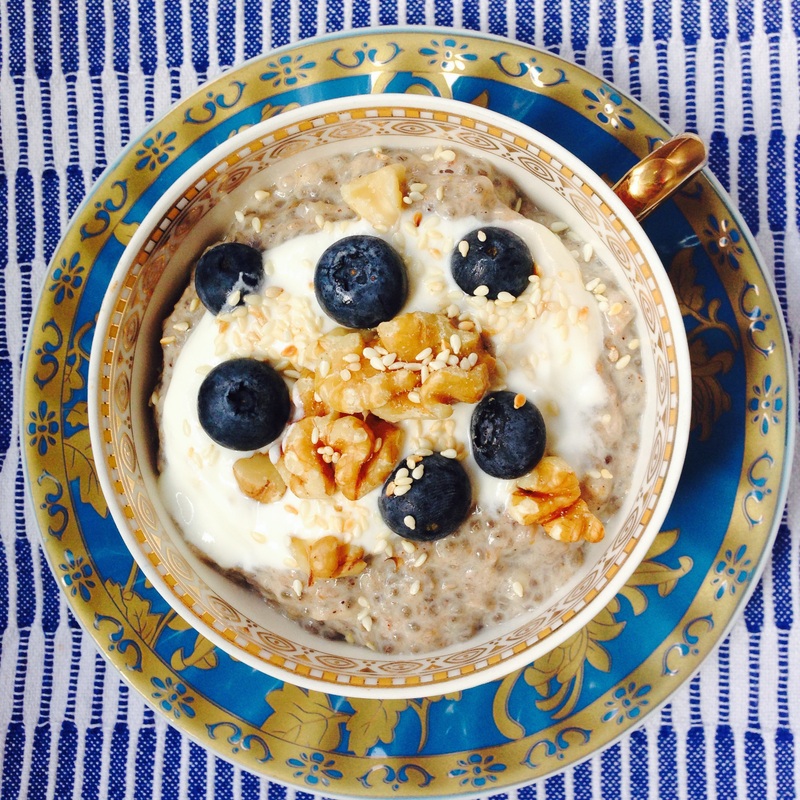 Whilst linguistically speaking the cha-cha is "a ballroom dance with small steps and swaying hip movements, performed to a Latin American rhythm. e.g. his feet began to move in an unmistakable cha-cha", the chia seed, like the cha-cha originated in Latin America. Ha! So why has the re-emergence of this tiny black, white and speckled seed caused so much excitement? With good merit I say. Salvia hispanica L (aka chia seeds) originated in Guatemala and Mexico in the pre columbian and Aztec periods and are touted for their neutraceutical benefits. The chia seed is well credentialed for its position on the functional super foods' list and has every right to have made its way back onto the dining table. Nutritionally speaking, they punch way above their weight with 1 tablespoon (12g) of chia containing a whopping 2500mg of the essential Omega 3 Alpha Linolenic fatty acid, 3g protein (including high levels of the lovely Tryptophan) and 4g fibre (hello healthy gut flora). Omega 3 fatty acids are famed for their anti-inflammatory health benefits including their ability to balance blood serum lipid levels, reduce LDL and increase HDL cholesterol. Chia seeds are full of phenolic antioxidants including Quercetin, Kaempferol and Myricetin which protect the body from free radical oxidation and reduce inflammation. They are rich in minerals such as Calcium, Phosphorous, Manganese, Iron, Magnesium and Zinc, which translates to healthy bones and teeth, improved immunity and haemoglobin synthesis. The amino acid, Tryptophan, which is the precursor to one the 3 important mood modulating neurotransmitters, serotonin, is found in high quantities in chia seeds. 2 tablespoons contains 202mg (equivalent to 60g serve of turkey). Chia seeds are hydrophilic, absorbing up to 10 times their weight in water. This makes them a fabulous hydrator and appetite suppressant. Their high protein and fibre content will ensure that adding them to any dish will decrease Glycemic load (meaning more balanced blood sugar levels.) Their high fibre content will increase gut transit time, assist with the beneficial maintenance of healthy gut flora and induce satiety. But wait there’s more. Chia seeds are also an incredibly versatile cooking ingredient. Once you learn their magical culinary powers, you will be converted. Chia seeds can be used to thicken stews, soups, & casseroles, as a base for warm and cold breakfast puddings, as a base for warm and cold dessert puddings, to thicken jams, mousses, custards, sauces & mayonnaises and as an egg replacer (1 tablespoon chia + 3 tablespoons water = 1 large egg). I have been trying to wean my family off a well known (fairly healthy) breakfast cereal for some years now and I have danced many a cha-cha in the effort. It was the chia breakie pudding that finally converted them ALL at the same time. Alleluia! It is a pretty versatile dish and can be prepared as a raw dish or on cold, rainy days can be served warm. Start with the seasonal fruit, add the liquid base of milk, yoghurt, coconut or almond milk or coconut water. Next add the chia seeds and spices. Ready to break the fast. The recipe for a delicious chia pudding can be found here Chia seeds are a member of the mint family and may have an allergenic effect in people who are allergic to sesame seeds and/ or mustard seeds.
0 Comments
|
Categories
All
Archives
April 2021
|

 RSS Feed
RSS Feed